US container imports plunge as economy and labour take their toll
According to the latest McCown Report US west coast ports saw a 22% decline in ...

Shippers and the wider supply chain need to be concerned about the resurgence of major US west coast port congestion next year, rather than writing it off as an historical anomaly.
The warning came from TradeTech president Bryn Heimbeck, who said it was “clear” the ports were not prepared to handle the mounting demand.
“One does not have to be omniscient, one just has to know there is a level that ports can handle, and that ...
Outlook for container shipping 'more uncertain now than at the onset of Covid'
Transpac container service closures mount
Shippers warned: don't under-value US exports to avoid tariffs – 'CBP will catch you'
Cancelled voyages take the sting out of spot rate declines this week
New Houthi warning to shipping as rebel group targets specific companies
Blanked sailings in response to falling demand 'just a stop-gap solution'
K+N CEO unveils impact of US import tariffs on China-origin goods
CMA CGM to reflag box ship as the French carrier eyes growing Indian market
UK pauses tariffs on 'everyday' items
Boeing looks to resell up to 50 aircraft rejected by Chinese buyers
'Strong start' to 2025, despite market uncertainty, says Kuehne + Nagel
US Customs chaos means 'more downside risk than upside potential' for air cargo
More pressure on transpacific rates as carriers bet on a China-US trade deal
Taiwan ministries act to mitigate effect of trade war on agriculture exports
Wan Hai joins box shipping 'arms race', but avoids Chinese yards for newbuilds

Comment on this article
Ramon Silva
December 14, 2023 at 3:42 pmOh no!!!! If this happens is no bueno! port congestion are likely linked to unfair demurrages and detention charges.